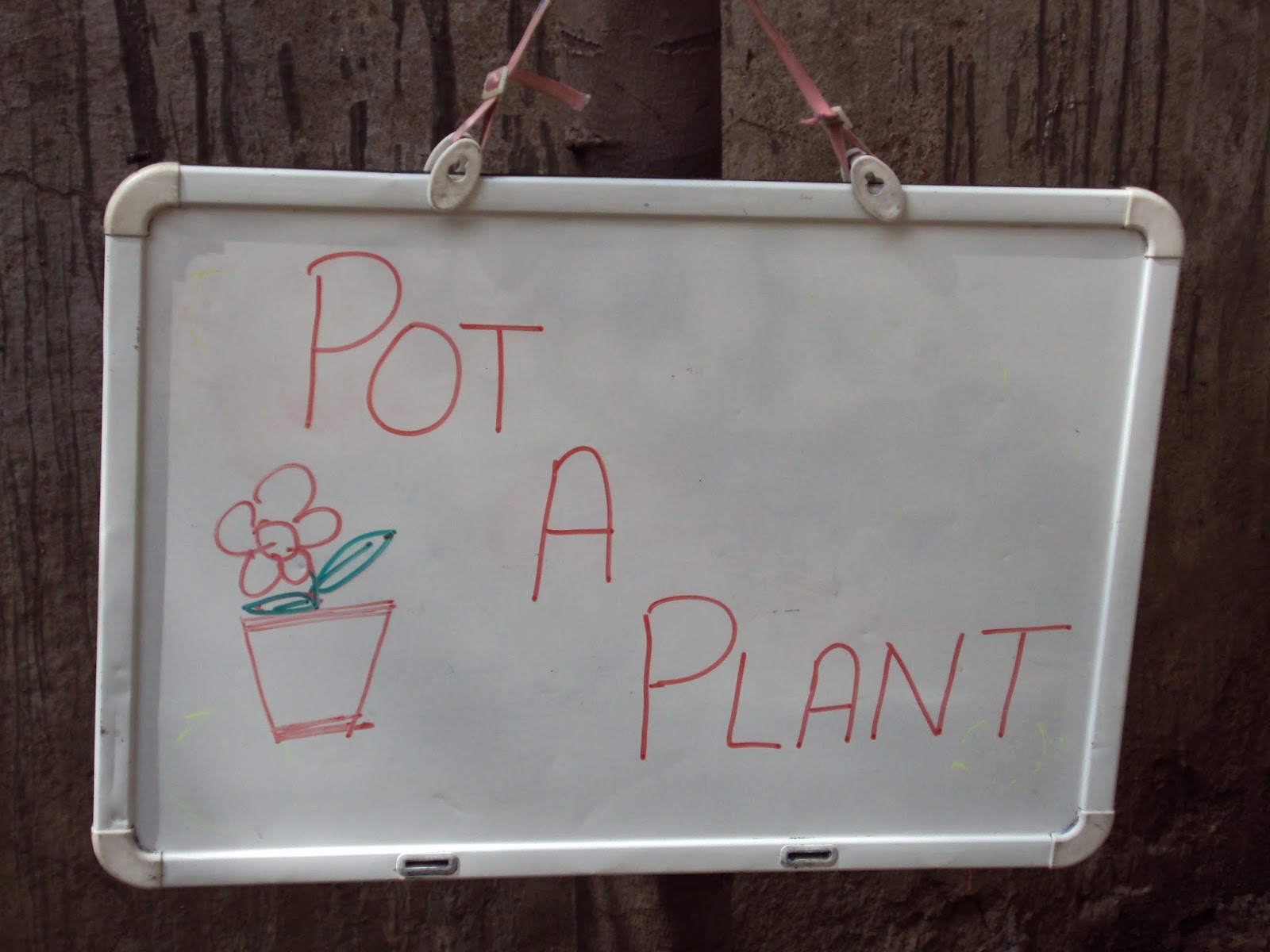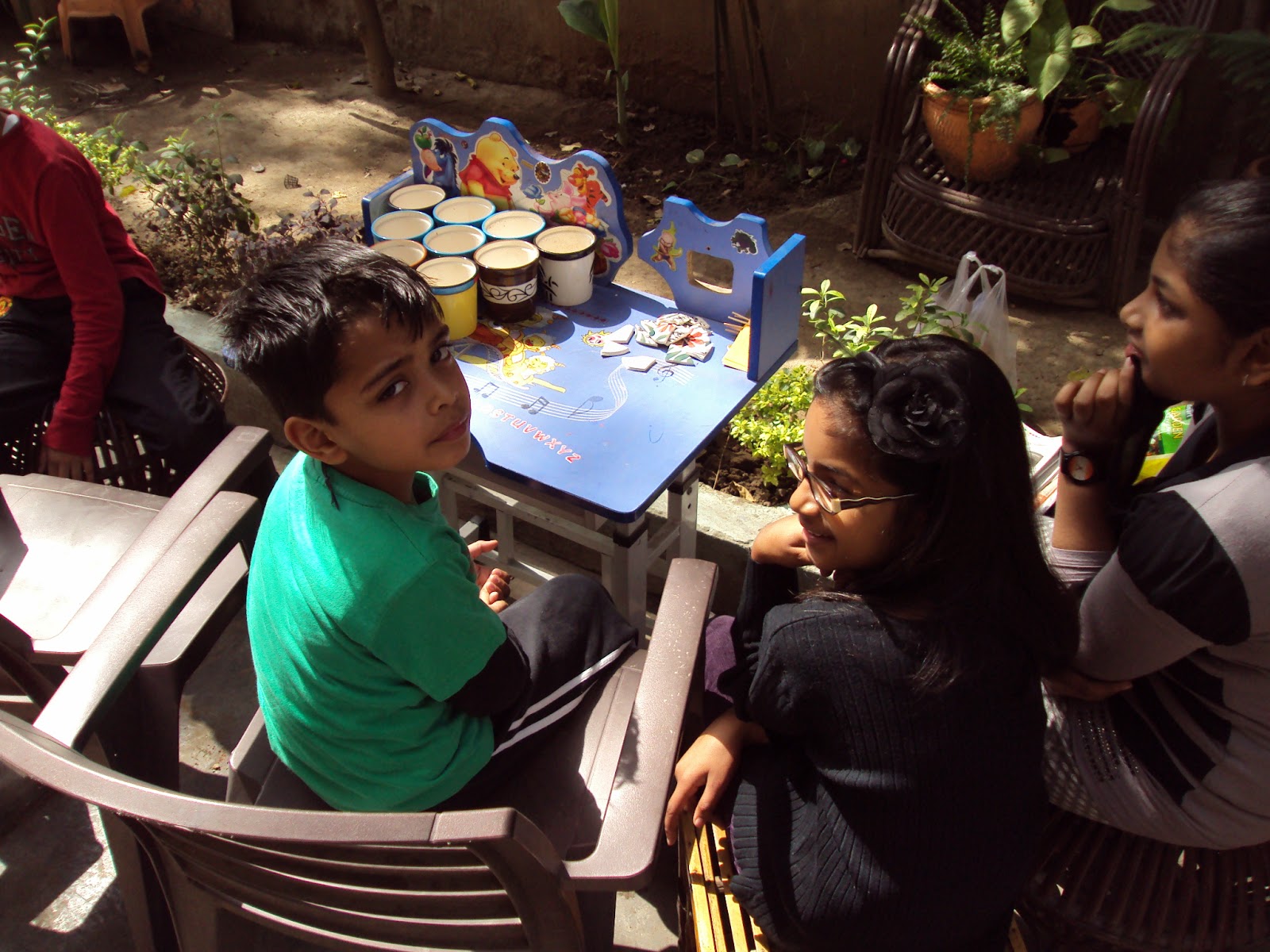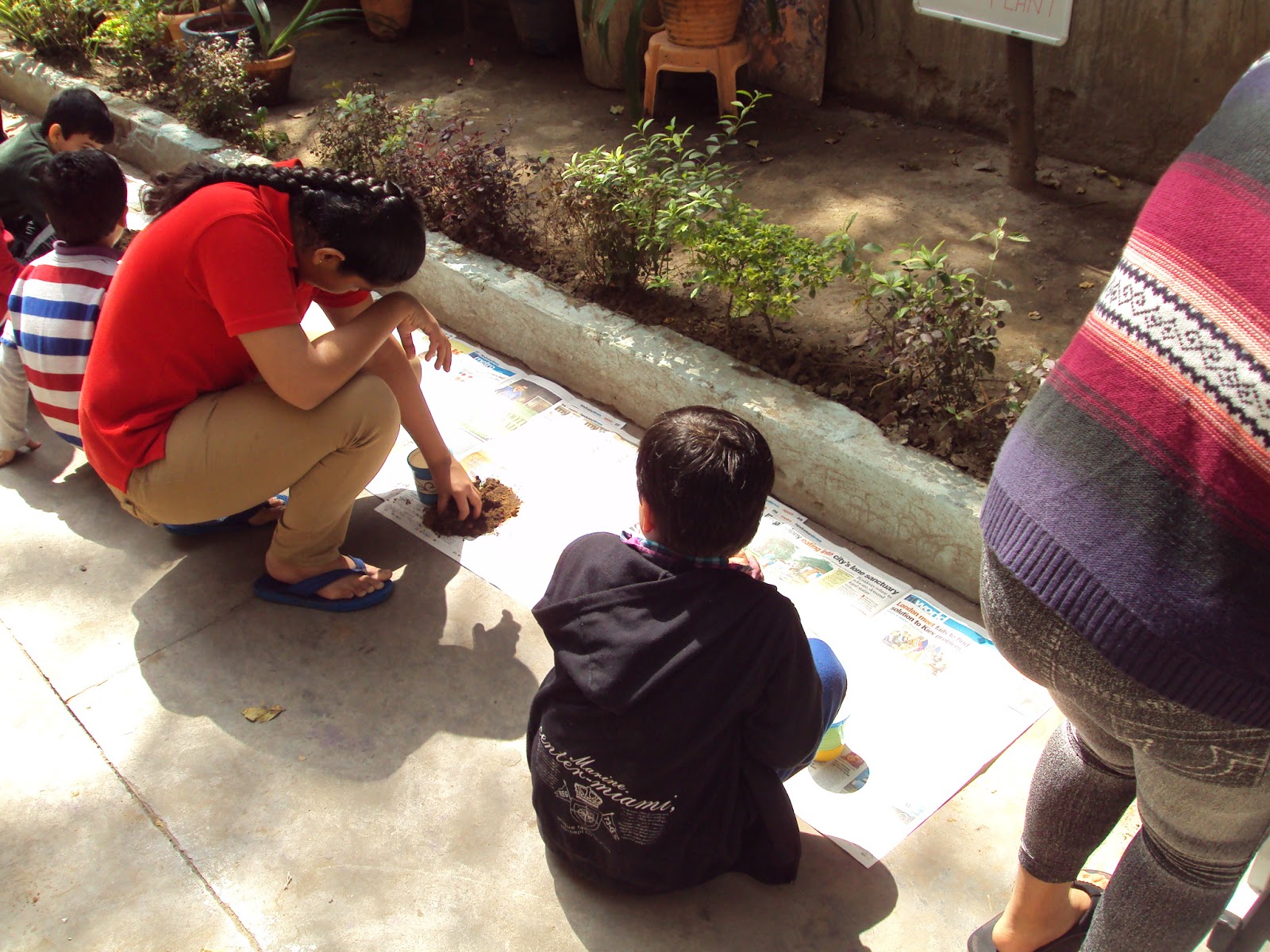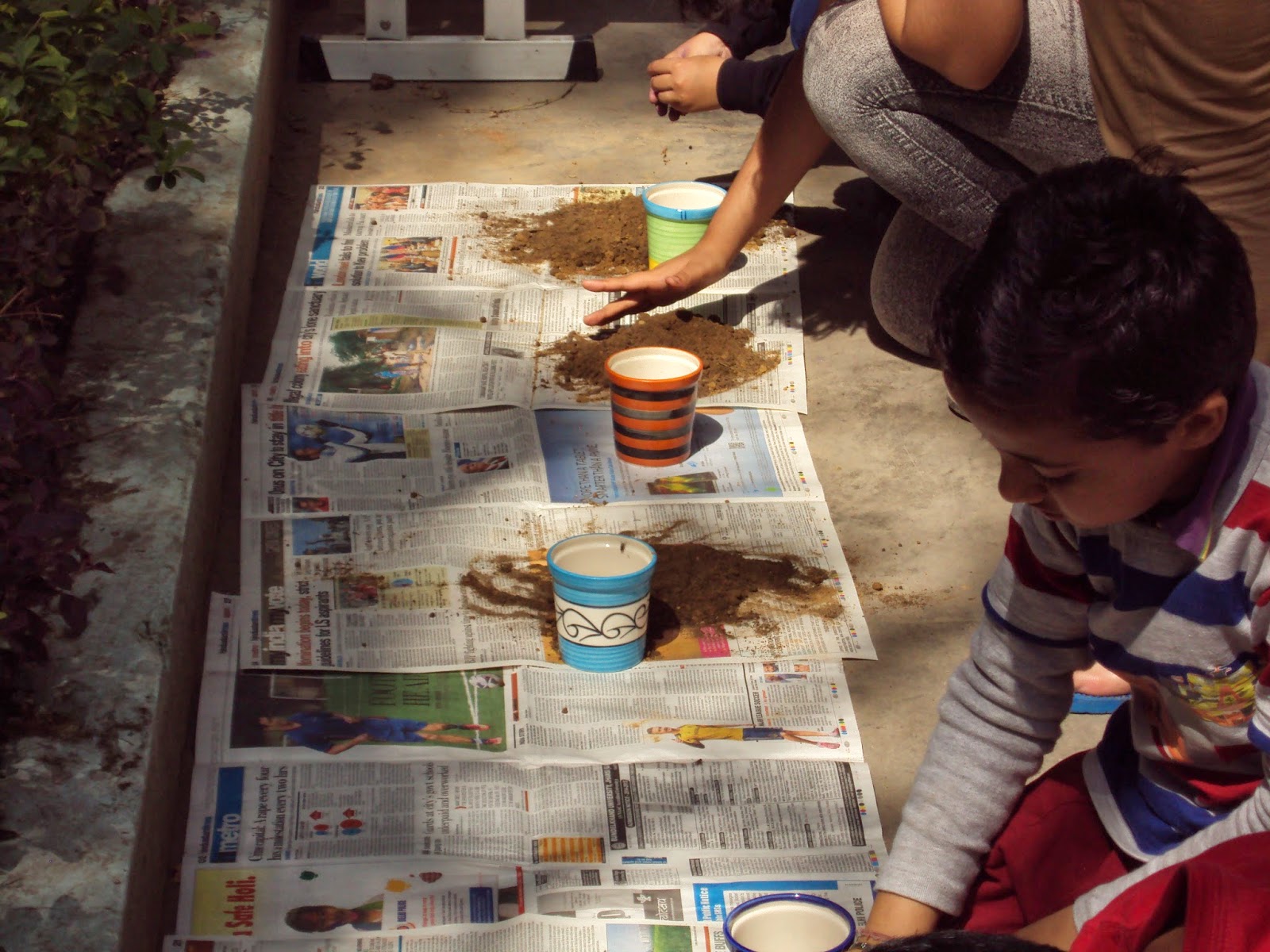One doesn't always have to plan forever to attain good results, and this is what my sister and I discovered when we conducted a 'Pot a Plant' session for the kids in our colony. We had been talking about this since last year, but when it came to the actual planning and prep work, it barely took us one hour to put it all together - right from collecting the material required, planning the session, inviting the kids, and setting up the venue.
Even though the idea came to us almost one year back when I and my sister were talking about doing something apart from our regular work and outside our schedules, we made a decision about the venue, date, content, and participants of the activity in a matter of seconds when we were walking around the gardening shops at the Garden Tourism Festival 2014 organized by Delhi Tourism. We bought 10 little ceramic pots - bright and colourful. And after that everything simply fell into place.
We decided upon the weekend - 16 March 2014, Sunday - just one day before Holi, and the venue would be our locality in Rohini. The session would be conducted at around 11 am, which won't be too early for the kids, nor too late so that their families could still utilize the rest of the day for any other outing they plan to do.
We decided that we would take the kids through the simplest possible process of potting a plant. The saplings that would be potted should be attractive to the kids, and should give gratifying results in a short period of time. In other words, something that would flower early. So we zeroed in on Portulaca Grandiflora, commonly known as the 10 o' clock plant because its flowers bloom at around that time and close within a couple of hours.
It took us half an hour to go pick up the saplings, compost, and soil from our local nursery, and a further 15 minutes to pick up fruit juice and snacks for the kids, so that they can re-energise themselves after working hard in the garden.
And once everything was set, we sent out the invitations to the kids - mostly my nephew's friends between 6 to 9 years of age. We invited 9 kids and then we could only sit and wait for the time to arrive - our exciting increasing with each passing minute. We were hoping that the children would also be as excited as us.
And we were happy to see almost all kids arrive at the venue 10 minutes before time and waiting for us to start the activity. We had invited 9, but 12 arrived. We had to drill holes in three ceramic glasses from our kitchen and give them to the kids that arrived last. Because of their punctuality, we were able to start dot on time. We started with talking about why it is important to have plants around us and then asking the kids whether any of them have ever potted a plant. Some of them had done it for some school projects, but most of the kids were new to this.
We told them about Pots, crocks (little pieces of broken pots placed above the hole at the bottom to help with drainage of excess water), watering can, soil, and compost, and were delighted by their enthusiasm, interest, attentiveness, and quick grasp. When it came to the practicals, the kids were required to stand in queues several times and demonstrate a lot of patience. Not one of them tried to break the queue. They observed carefully and executed perfectly. The only complain we heard from them was about the smell of compost. By the end of it, all kids had selected their favourite pots, placed crocks in them, mixed soil and compost, and planted the sapling.
We then explained to them about the process of watering and how to decide when their plants needed water. We told them about the benefits of sunlight and the harms of overwatering. We also prepared them about the natural lifecycle of the plant, and told them that the plant would die at the end of summers and they should not feel disheartened when it did.
The kids promised to take care of their plants and to let us know when the first flower blooms. Kids were happy and really charged up. All this while, they had been sitting on the ground and getting their hands dirty. Once they were done, they washed their hands properly with soap and grabbed their juices and snacks. They were highly protective of their plants and left us with cheerful goodbyes, their faces glowing.
Once they had left, we realized that several people had been looking down from their windows and observing us and the kids. One of them shouted "this is the perfect way to celebrate Holi" and we were delighted that everyone was able to appreciate the importance of introducing the little ones to gardening. If this is the case, then we do not have too many reasons to worry about the future. The receptiveness of our youngsters and the willingness of our contemporaries will ensure that we stay close to nature.
More than anything else, this activity gave us the confidence that we can organize such activities in the future as well. We are now contemplating having a series of such activities during the summer vacations, and hopefully, we will be able to hold the interest of the kids through them too. Looking forward to a busy summer. :)
Even though the idea came to us almost one year back when I and my sister were talking about doing something apart from our regular work and outside our schedules, we made a decision about the venue, date, content, and participants of the activity in a matter of seconds when we were walking around the gardening shops at the Garden Tourism Festival 2014 organized by Delhi Tourism. We bought 10 little ceramic pots - bright and colourful. And after that everything simply fell into place.
We decided upon the weekend - 16 March 2014, Sunday - just one day before Holi, and the venue would be our locality in Rohini. The session would be conducted at around 11 am, which won't be too early for the kids, nor too late so that their families could still utilize the rest of the day for any other outing they plan to do.
We decided that we would take the kids through the simplest possible process of potting a plant. The saplings that would be potted should be attractive to the kids, and should give gratifying results in a short period of time. In other words, something that would flower early. So we zeroed in on Portulaca Grandiflora, commonly known as the 10 o' clock plant because its flowers bloom at around that time and close within a couple of hours.
It took us half an hour to go pick up the saplings, compost, and soil from our local nursery, and a further 15 minutes to pick up fruit juice and snacks for the kids, so that they can re-energise themselves after working hard in the garden.
And once everything was set, we sent out the invitations to the kids - mostly my nephew's friends between 6 to 9 years of age. We invited 9 kids and then we could only sit and wait for the time to arrive - our exciting increasing with each passing minute. We were hoping that the children would also be as excited as us.
And we were happy to see almost all kids arrive at the venue 10 minutes before time and waiting for us to start the activity. We had invited 9, but 12 arrived. We had to drill holes in three ceramic glasses from our kitchen and give them to the kids that arrived last. Because of their punctuality, we were able to start dot on time. We started with talking about why it is important to have plants around us and then asking the kids whether any of them have ever potted a plant. Some of them had done it for some school projects, but most of the kids were new to this.
We told them about Pots, crocks (little pieces of broken pots placed above the hole at the bottom to help with drainage of excess water), watering can, soil, and compost, and were delighted by their enthusiasm, interest, attentiveness, and quick grasp. When it came to the practicals, the kids were required to stand in queues several times and demonstrate a lot of patience. Not one of them tried to break the queue. They observed carefully and executed perfectly. The only complain we heard from them was about the smell of compost. By the end of it, all kids had selected their favourite pots, placed crocks in them, mixed soil and compost, and planted the sapling.
We then explained to them about the process of watering and how to decide when their plants needed water. We told them about the benefits of sunlight and the harms of overwatering. We also prepared them about the natural lifecycle of the plant, and told them that the plant would die at the end of summers and they should not feel disheartened when it did.
The kids promised to take care of their plants and to let us know when the first flower blooms. Kids were happy and really charged up. All this while, they had been sitting on the ground and getting their hands dirty. Once they were done, they washed their hands properly with soap and grabbed their juices and snacks. They were highly protective of their plants and left us with cheerful goodbyes, their faces glowing.
Once they had left, we realized that several people had been looking down from their windows and observing us and the kids. One of them shouted "this is the perfect way to celebrate Holi" and we were delighted that everyone was able to appreciate the importance of introducing the little ones to gardening. If this is the case, then we do not have too many reasons to worry about the future. The receptiveness of our youngsters and the willingness of our contemporaries will ensure that we stay close to nature.
More than anything else, this activity gave us the confidence that we can organize such activities in the future as well. We are now contemplating having a series of such activities during the summer vacations, and hopefully, we will be able to hold the interest of the kids through them too. Looking forward to a busy summer. :)

















.jpg)
Comments
I missed this one but would definitely make a point to join for next session.
It's really good to hear that other kids also showed interest and joined the session on time. I am super impressed with punctuality of kids. There is always a complaint about Delhi people that they hardly come on time and things usually start late. This is surely a very good indicator that Delhi is changing for positive :)
Definitely, it's a brilliant way to celebrate Holi and making our places greener/colorful.
Cheers !
I would like to believe that Delhi is changing for good too.... :)
Pls plan smthin when i m in Rohini:)
:)